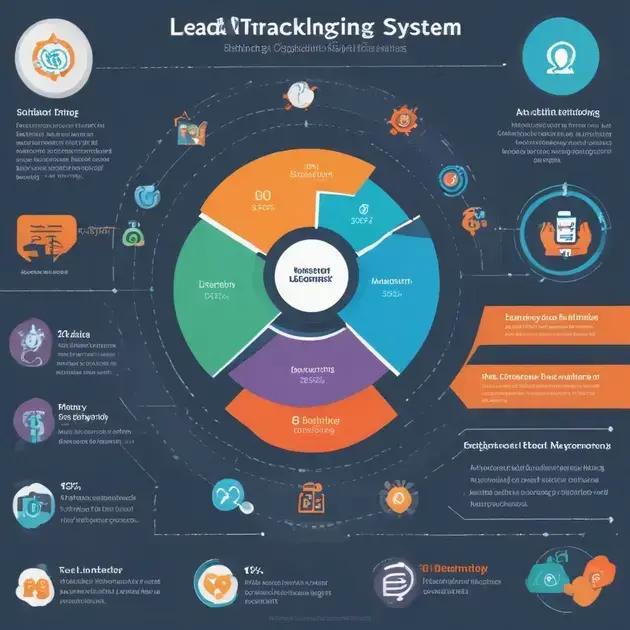A lead tracking system is a vital tool for businesses to manage potential customers effectively. It enhances organization, improves follow-up, and boosts overall sales efficiency, leading to stronger customer relationships and improved conversion rates.
A lead tracking system can significantly enhance your business operations by organizing and managing potential leads efficiently. This technology helps sales teams monitor interactions, follow up promptly, and close deals more effectively. In this article, we’ll delve into what a lead tracking system is, its benefits, and how to implement it to optimize your sales processes.
What is a Lead Tracking System?
A lead tracking system is a tool designed to help businesses manage and monitor potential customers through the sales funnel. This system allows sales teams to collect and organize information about leads, including their contact details, the source from which they originated, and their interactions with the company.
Key Features of a Lead Tracking System
A good lead tracking system offers features like lead scoring, automated follow-up reminders, and reporting capabilities. These features help teams prioritize their leads and increase their chances of closing sales.
How It Works
When a potential customer expresses interest, their information is entered into the lead tracking system. Sales representatives can then use this system to follow up with personalized messages and track the lead’s path toward making a purchase. The interaction history is essential for understanding what the lead needs and how to best convert them into a customer.
The Importance of Lead Tracking
Without a proper lead tracking system, businesses risk losing valuable leads due to poor follow-up or missed opportunities. By implementing such a system, companies can ensure they are always aware of where each potential customer stands in the buying process. This leads to improved communication and increased sales efficiency.
Benefits of Using a Lead Tracking System

Implementing a lead tracking system offers many advantages for businesses striving to grow their sales and improve customer interactions. This system streamlines processes and ensures that potential customers are never overlooked. Below are some key benefits of using a lead tracking system.
Enhanced Organization
A lead tracking system helps organize information efficiently. All lead data is stored in one place, making it easy for sales representatives to access and manage prospects. This organization helps eliminate confusion and reduces the risk of losing leads due to a lack of follow-up.
Improved Lead Management
With a lead tracking system, businesses can prioritize leads based on their buying signals or engagement levels. This means sales teams can focus their efforts on high-potential leads, increasing the chances of conversion. A structured approach to lead management also enables teams to track every interaction, ensuring timely follow-ups.
Increased Sales Efficiency
When sales teams have all the information they need at their fingertips, they can work more efficiently. A lead tracking system automates many repetitive tasks, such as reminding sales representatives to follow up with leads or providing insights into the best times to contact them. This efficiency can lead to increased productivity and higher sales volumes.
Data-Driven Insights
Lead tracking systems provide valuable data about customer behavior and preferences. Businesses can analyze this data to refine their marketing strategies, target specific demographics more effectively, and enhance overall campaign performance. Understanding trends and patterns in lead behavior helps businesses make informed decisions.
Stronger Customer Relationships
Using a lead tracking system enables businesses to build stronger relationships with customers. By keeping detailed records of interactions and preferences, sales teams can personalize their communication and follow-ups. This personalized approach fosters trust and encourages customers to engage more deeply with the brand.
How to Choose the Right Lead Tracking System
Choosing the right lead tracking system is crucial for enhancing your sales processes and ensuring accurate lead management. Here are some key factors to consider when selecting the best system for your business.
Identify Your Needs
Before exploring options, it’s essential to identify your specific needs. Determine what features are most important for your team. This may include functionalities like automated follow-ups, lead scoring, or integration with other tools.
Evaluate User-Friendliness
A great lead tracking system should be easy to use. Review the interface and make sure it is intuitive enough for your team to navigate without extensive training. A user-friendly system increases adoption rates and ensures that your team utilizes all available features effectively.
Consider Scalability
Your chosen system should be able to grow with your business. As your company expands, you might need additional features or the capacity to handle more leads. Look for systems that offer scalable options to prevent the need for switching systems in the future.
Check for Integration
It’s important to consider how the lead tracking system will fit into your existing workflow. Verify that it integrates well with other tools you currently use, such as CRM systems, marketing platforms, and email services. Smooth integration can streamline processes and enhance efficiency.
Read Reviews and Testimonials
Before making a decision, research online reviews and testimonials from current users. This can provide valuable insight into the effectiveness and reliability of various lead tracking systems. Look for feedback focusing on customer support, feature performance, and overall satisfaction.
Implementing a Lead Tracking System Effectively

Implementing a lead tracking system effectively is important for maximizing its benefits and ensuring smooth operation. Here are the key steps to follow for successful implementation.
Define Clear Goals
Start by setting clear objectives for what you hope to achieve with the lead tracking system. Whether it’s improving follow-up times, increasing conversion rates, or enhancing customer relationships, having specific goals will guide your implementation process.
Train Your Team
One of the most critical steps is to ensure that your team is trained to use the system effectively. Provide comprehensive training sessions to show them how to navigate the software, input data, and utilize its features. Ongoing support and resources should also be available to help them troubleshoot issues.
Integrate with Existing Tools
Make sure the lead tracking system integrates smoothly with your existing tools. This includes your CRM, email marketing software, and any other platforms your team uses. Integration allows for easy data sharing and ensures a seamless workflow across your business operations.
Monitor and Optimize
Once the system is in place, continuously monitor its performance. Gather feedback from your team and analyze data to see what is working and what isn’t. Use this information to make necessary adjustments to improve the system’s effectiveness over time.
Encourage a Culture of Data Usage
Lastly, foster a culture where your team understands the importance of data tracking and usage. Encourage them to consistently input information and utilize the system for all lead-related activities. This will enhance its value and contribute to better decision-making across your organization.
Common Pitfalls in Lead Tracking Systems
Implementing a lead tracking system can significantly improve sales processes, but there are common pitfalls to avoid. Understanding these challenges can help you make the most of your system.
Neglecting Data Quality
One of the biggest mistakes is ignoring the quality of the data entered into the system. Inaccurate or outdated information can lead to poor decision-making. Always ensure that team members follow guidelines for data entry and regularly update lead information.
Inadequate Training
Another common issue is not providing sufficient training for your team. If your staff does not fully understand how to use the lead tracking system, they may not utilize it effectively. Comprehensive training sessions and ongoing support are crucial.
Focusing Too Much on Technology
While picking the right software is essential, focusing too much on technology can lead to neglecting the human element. It’s important to build strong relationships and communication patterns within your sales teams and with leads themselves.
Failing to Set Clear Objectives
Implementing a lead tracking system without clear goals can lead to confusion and ineffective use of resources. Ensure that your team knows what they are working towards, like improving conversion rates or response times.
Overlooking Integration
Ignoring the need for integration with other tools can lead to data silos, making it difficult for sales teams to access important insights. Ensure that the lead tracking system aligns well with your existing CRM and marketing platforms for streamlined workflows.
In Summary: The Impact of a Lead Tracking System
A lead tracking system can transform how your business manages potential customers. By organizing data, improving communication, and helping prioritize leads, it can lead to higher conversion rates.
However, it is important to avoid common pitfalls like neglecting data quality, inadequate training, and failing to set clear goals. By understanding these challenges, you can ensure a successful implementation.
With the right approach, a lead tracking system can not only streamline your sales process but also foster stronger relationships with your customers. Embrace the potential of this technology to drive your business forward.
FAQ – Frequently Asked Questions about Lead Tracking Systems
What is a lead tracking system?
A lead tracking system is a tool that helps businesses manage and monitor potential customers throughout the sales process.
Why is data quality important in a lead tracking system?
Data quality is crucial because inaccurate information can lead to poor decisions and missed sales opportunities.
How can I ensure my team effectively uses the lead tracking system?
Provide comprehensive training and ongoing support to help your team understand how to utilize the system to its fullest potential.
What are common pitfalls when implementing a lead tracking system?
Common pitfalls include neglecting data quality, inadequate training, and failing to set clear objectives.
How can integration improve my lead tracking system?
Integrating your lead tracking system with other tools ensures data flows smoothly, enhances communication, and streamlines workflows.
What benefits can I expect from using a lead tracking system?
You can expect enhanced organization, improved lead management, increased sales efficiency, and stronger customer relationships.




